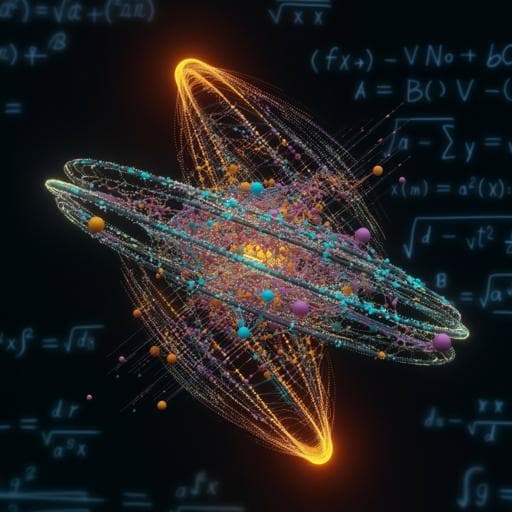
Engineering and Technology
Multi-level physics informed deep learning for solving partial differential equations in computational structural mechanics
W. He, J. Li, et al.
Introducing the ml-PINN framework, a groundbreaking approach by Weiwei He, Jinzhao Li, Xuan Kong, and Lu Deng for solving complex fourth-order PDEs in computational structural mechanics. This innovative method enhances accuracy and speed beyond classical PINNs, paving the way for real-time simulations in digital twin systems.
~3 min • Beginner • English
Introduction
Structural mechanics computation is fundamental for design and analysis in civil and structural engineering, and real-time, accurate simulation is increasingly required for Digital Twin (DT) systems. Conventional finite element method (FEM) workflows face limitations for DT integration: they are time-consuming and cumbersome for repeated analyses, difficult to integrate into DT platforms, and unsuitable for infinite-domain or inverse problems. Recent advances in AI and deep learning have been applied to structural tasks (e.g., damage identification, optimization, performance prediction), but purely data-driven models need large high-quality datasets and lack physical interpretability. Physics-informed neural networks (PINNs) address this by embedding PDE physics with or without labeled data and can handle unknown boundary/initial conditions, serving as fast surrogate models after training. Yet, for bending structures, PINNs struggle due to fourth-order nonlinear governing PDEs, where higher-order derivatives degrade accuracy and differing derivative orders cause loss scaling issues and unstable or non-convergence. To overcome these challenges, the study proposes a multi-level PINN (ml-PINN) that decomposes high-order PDEs into coupled lower-order equations reflecting geometric, constitutive, and equilibrium relations, trained via multiple linked neural networks, and validates it on beam and shell benchmarks against FEM.
Literature Review
The paper reviews applications of AI and deep learning in structural engineering (e.g., crack detection, parameter optimization, performance prediction) and notes explainable AI efforts (e.g., SHAP) that still struggle to encode physics. It summarizes the emergence of PINNs for embedding PDE constraints, handling unknown boundary/initial conditions, and enabling surrogate modeling. PINN applications span shape optimization, thermochemical curing, crack quantification, additive manufacturing, seismic response, nonlinear modeling, structural design, defect identification, and subsurface flow, with method extensions for optimized training, surrogate modeling, multi-physics, fluids, solids, transfer learning, and elastodynamics. PINN usage is categorized into inverse problems (parameter identification) and forward problems (PDE solvers without labels). Prior forward-PINN works often tailor frameworks to specific PDEs. Compared to FEM, PINNs are meshless and flexible in fusing data and physics, but high-order PDEs in structural bending pose accuracy and convergence issues due to multiple derivative orders in loss terms. This motivates multi-network, lower-order reformulations like the proposed ml-PINN.
Methodology
The proposed ml-PINN reduces high-order structural PDEs into coupled lower-order equations and trains multiple neural networks (NNs) linked through physics-based loss terms and boundary condition losses.
1) 1D Beam formulation:
- Governing equation (Euler–Bernoulli bending): d⁴ω/dx⁴ = q(x)/EI, where ω is vertical displacement, q(x) is load, EI is flexural stiffness.
- Decomposition into five first-order ODEs introducing intermediates: q = dF₀/dx; F₀ = dM/dx; M = −EI κ; κ = dθ/dx; θ = dω/dx. These correspond to equilibrium, constitutive (stress–strain), and geometric relations.
- Architecture: Four separate fully connected feedforward NNs output ω, θ, M, and F₀ (ωNN, θNN, MNN, F0NN). Each has input dimension 1 (x), 3 hidden layers with 10 nodes, and 1 output node (for ml-PINN). A classical single-network PINN (c-PINN) baseline uses 1 input, 3 hidden layers with 20 nodes, and 1 output, capacity-matched overall.
- Collocation and BCs: Random interior collocation points for PDE residuals and boundary points for BCs. Boundary types include: (i) ω and θ prescribed on boundary s1; (ii) ω and M prescribed on boundary s2 (simply supported: ω̄ = 0, M̄ = 0).
- Loss: Total loss Ltotal = LP + LB. LP aggregates residuals of geometric and equilibrium equations via automatic differentiation for first derivatives; the linear κ–M constitutive relation can be omitted from LP. LB enforces boundary ω, θ, and M directly at boundary points. Network parameters {W,b} are optimized to minimize Ltotal.
2) 2D Shell formulation:
- Governing PDEs include geometric relations between ω and curvatures κx, κy, κxy; linear elastic constitutive relations M = Dc·[κx, κy, κxy]^T (with E, t, ν in Dc); and equilibrium: ∂²Mx/∂x² + 2∂²Mxy/∂x∂y + ∂²My/∂y² + q(x,y) = 0.
- Architecture: Three NNs: ωNN (input 2: x,y; 3 hidden layers×30 nodes; 1 output), κNN (input 2; 3 hidden layers×20 nodes; 3 outputs for κx, κy, κxy), and MNN (input 2; 3 hidden layers×20 nodes; 3 outputs for Mx, My, Mxy).
- Collocation and BCs: Random interior points Ω and boundary points along S1–S4. Two boundary condition types include prescribed ω and θn (normal rotation) or prescribed ω and bending moments M on designated boundaries.
- Loss: LP sums residuals of geometric (ω–κ via second derivatives), constitutive (κ–M), and equilibrium (M second derivatives with q) equations. LB includes boundary ω, rotations (ω′/θ), and M. Automatic differentiation computes first/second-order derivatives needed.
3) Training details and optimization:
- Optimizer: ADAM with learning rate 1e−3.
- Collocation sensitivity: Beams were trained with 10–100 interior points; shells with 100–2000 interior points and 50 points per boundary side.
- Multi-network aggregation and linked losses alleviate loss scaling from mixed derivative orders and allow direct BC enforcement on each NN. Networks are trained until loss convergence.
4) Generalization setting:
- For rapid prediction under varying loads and boundary inputs, physical variables related to loading (e.g., boundary displacement u and uniform load q) are included as additional inputs to the networks, enabling a single trained model to generalize across scenarios.
Key Findings
- Accuracy vs FEM: For 1D beams across four loading/boundary cases, ml-PINN vertical displacements match FEM with relative error < 0.5% and nearly overlapping deformation profiles. For 2D shells across four cases, overall relative errors are < 2%; larger errors appear near corners with concentrated constraints.
- Sensitivity to collocation points:
• Beam: With sparse points (nP ≤ 10), errors ~3%; increasing to nP > 25 reduces errors to <1%. Reported errors and residuals include: nP=10: LP/nP=1.077×10^−7, LB/nB=8.426×10^−4, error (2.50±1.5)% ; nP=25: LP/nP=1.760×10^−7, LB/nB=3.749×10^−4, error (0.68±0.3)% ; nP=50: LP/nP=2.955×10^−8, LB/nB=9.299×10^−10, error (0.36±0.2)% ; nP=100: LP/nP=6.123×10^−9, LB/nB=4.170×10^−12, error (0.068±0.03)%.
• Shell: Dense interior points are needed: nP=100: error (9.01±5)% ; nP=500: (2.94±1)% ; nP=1000: (2.03±0.8)% ; nP=2000: (1.59±0.6)%. Corresponding residuals decrease with more points.
- Convergence and stability: Decomposing fourth-order PDEs into first-/second-order relations with separate NNs reduces loss scale disparity and improves both local and global convergence, avoiding non-convergence observed with classical single-NN PINNs for high-order PDEs.
- Efficiency: The ml-PINN achieves approximately four times faster computation time than the classical PINN while improving accuracy (beam ~0.5%, shell ~2%).
- Generalization: Including load and boundary variables as inputs enables direct prediction for unseen loading conditions with accuracy comparable to FEM, enhancing computational efficiency for parametric studies.
Discussion
The research addresses the core challenge of applying PINNs to high-order structural mechanics PDEs by reformulating fourth-order bending equations into coupled lower-order physics relations and training multiple linked networks. This reduces derivative order in loss terms, aligns loss magnitudes across variables, and allows direct enforcement of boundary conditions in each NN. As a result, ml-PINN stabilizes training and attains both local and global convergence. Empirically, ml-PINN matches FEM accuracy for beams (<0.5% error) and shells (<2% error), with corner discrepancies reflecting more complex constraints. Sensitivity analyses confirm the necessity of adequate collocation density, especially for 2D shells. The approach yields notable speedups (≈4×) over classical PINN and, with generalization inputs (u, q), enables rapid predictions across loading cases, making it suitable as a DT-ready surrogate. The underlying strategy—leveraging geometric, constitutive, and equilibrium relations to lower PDE order—suggests applicability to broader solid mechanics problems with similar governing structures.
Conclusion
This work introduces a multi-level PINN (ml-PINN) that aggregates multiple neural networks linked by physics-based losses to solve high-order structural mechanics PDEs by decomposing them into lower-order equations. Validations on 1D beams and 2D shells demonstrate accuracy comparable to FEM (errors ~0.5% and ~2%, respectively) with improved training stability and ≈4× faster computation than classical single-network PINNs. The framework directly enforces boundary conditions in each sub-network, mitigates loss scaling from mixed derivative orders, and supports generalization across loading conditions by augmenting inputs. The method shows promise as an intelligent, meshless computational module for structural DT systems and can be extended to other solid mechanics problems governed by similar PDE properties. Future work can focus on reducing training time, improving convergence in regions with complex constraints (e.g., corners), and exploring adaptive collocation and advanced optimization strategies to further enhance scalability.
Limitations
- Training time: As with many forward PINN approaches, training is time-consuming, particularly for 2D shells where higher dimensionality and second-order derivatives require more iterations for convergence.
- Collocation density: Accurate solutions, especially for 2D shells, require dense interior collocation points (e.g., ~1000), impacting computational cost.
- Boundary complexity: Errors are higher near corners and boundaries with multiple constraints, indicating convergence difficulty in these regions.
- Applicability scope: While the approach is generalizable to similar PDE structures, performance on more complex material behaviors or nonlinear constitutive laws may require additional adaptations (e.g., enhanced constitutive loss handling).
Related Publications
Explore these studies to deepen your understanding of the subject.







